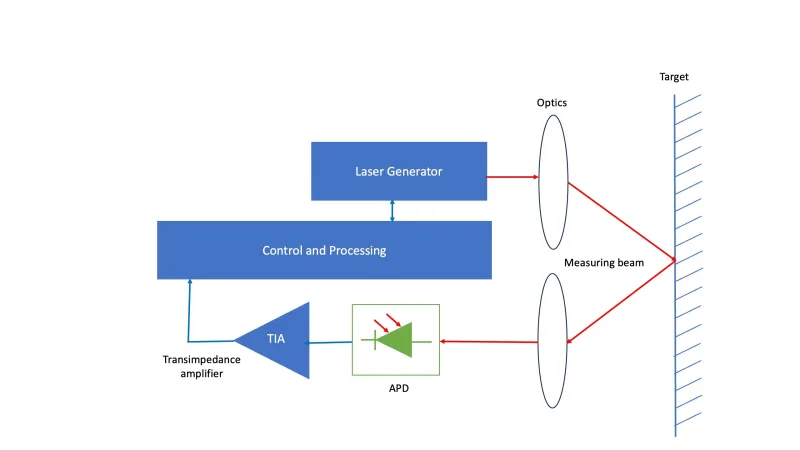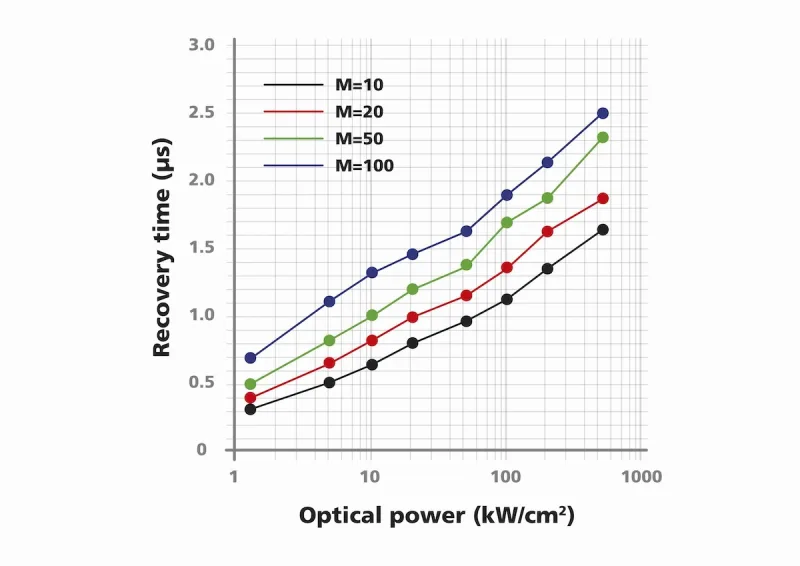The importance of impulse response in time-of-flight laser measurement systems
What are ToF Systems?
Time-of-flight (ToF) technology measures the time it takes for a light pulse to travel from a source to an object and back to the sensor. This travel time is proportional to the distance between the sensor and the object.
ToF systems emit a pulsed light beam, usually from a laser diode, and detect the reflected light from objects in the beam's path. There are two main types of ToF systems. Direct ToF measures the time delay between the emission and reception of a light pulse, requiring high-speed electronics for precise timing. Indirect ToF uses continuous wave modulation and measures the phase shift between the emitted and reflected light to determine distance.
Typical applications include laser rangefinders (LRF), LiDAR, and optical time-domain reflectometers (OTDRs) used to test optical fiber networks.
Key Components of ToF Systems
The laser generator emits modulated light, typically in the near-infrared range, as pulsed or continuous wave signals. Photodetectors capture the reflected light, typically using Avalanche Photodiodes (APDs) known for their high sensitivity and ability to amplify weak infrared signals through avalanche multiplication. Transimpedance Amplifiers (TIAs) then convert the current generated when light strikes the APDs into a voltage signal. Accurate matching of the APD output to the TIA is essential for fast recovery times and accurate distance measurements.

Why Fast Recovery Times Are Important
Fast recovery times are crucial for sensors used in infrared ToF systems because they rely on the quick emission and reception of light pulses to measure distances accurately and efficiently. This can be particularly challenging in high-power applications. For example, a large laser rangefinder might launch a 1MW peak signal and a powerful reflection from a nearby object can easily saturate or permanently damage sensors.
ToF sensors perform measurements at the nanosecond level. Fast recovery times allow the sensor to quickly reset after detecting a light pulse, enabling real-time data acquisition. Infrared ToF systems often encounter varying signal intensities due to different surface reflectivities. Fast recovery times help sensors adapt to these changes without saturation or damage. Also, minimising the delay between consecutive measurements and reducing the latency between light pulse emissions leads to more frequent and accurate distance calculations.
Applications requiring real-time data include LiDAR systems in autonomous vehicles for obstacle detection and navigation, as well as in manufacturing, logistics, and smart buildings for tasks like pallet localization, obstacle detection, and motion detection.
What Noiseless InGaAs APDs Bring to System Performance
Phlux's Noiseless InGaAs® APDs deliver up to 12 times higher sensitivity and produce less than one-tenth of the noise compared to traditional InGaAs APDs. This is achieved by incorporating antimony alloys into the diodes' epitaxial structure,
The devices can withstand high optical powers, with tests showing continuing functionality after exposure to infrared laser pulses at powers as high as 40 MW/cm². A prototype receiver module developed by Phlux demonstrated an overload recovery time of below 1.5 µs at a gain (M) of 10 and 2.5 µs at M 100 when exposed to optical power of 500 kW/cm². This rapid recovery time ensures the APD can quickly respond to subsequent signals, improving the system's ability to handle varying signal intensities.

By co-designing the APD and TIA, Phlux enhanced the precision of distance measurements and system resilience. The prototype module can distinguish between pulses arriving just 10 ns apart, which is crucial for accurate timing and high-resolution distance measurements. This capability is particularly beneficial for LiDAR systems in autonomous vehicles, where precise object detection is necessary for safe navigation. Tailoring the TIA design to the application is always an important consideration for optimising many aspects of system performance.
Conclusion
ToF technology, with its ability to measure distances accurately and quickly, is revolutionising various applications, including autonomous driving. The key components, such as illumination units, APDs, and TIAs, play a vital role in the system's performance. Phlux's Noiseless InGaAs® APDs, with their enhanced sensitivity, low noise, high damage threshold, and fast recovery times, offer significant improvements, making them ideal for advanced LiDAR systems and other high-performance applications.
This in-depth guide to Noiseless InGaAs® APDs provides more detailed technical information about their performance.